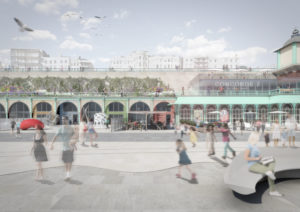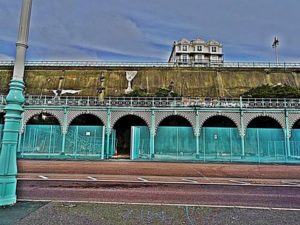Plans to restore the Madeira Terraces and create glass-fronted shops, cafes, offices and even overnight beach huts underneath have been unveiled today.

The listed Victorian terraces have been closed since 2013, when a routine survey uncovered structural concerns. Subsequent surveys have uncovered substantial corrosion of the cast iron fixings keeping the 130-year-old structure up, leading to further closures and the relocation of several businesses.
Campaigners have been pushing hard for Brighton and Hove City Council to publish its plans, after they were first promised at the beginning of the year.
As expected, they include a commercial element in the form of the units. The ironwork will be restored where possible, and replaced with replicas where necessary. The council says it will also try and preserve the Green Wall, which predates the terraces.
The council says it will be be bidding for £4million of coastal communities fund money to get the £20-30million project started, with further money coming from other grants, private investment and possibly borrowing from the Public Works Loan Board, the way the bulk of the i360 has been funded.

The announcement comes in the wake of the Victorian Society’s rival survey carried out by specialist historic surveyors the Morton Partnership, which suggested that the terraces could be repaired for a fraction of the cost the council’s surveyors estimated – which led to inaccurate local media reports that the council was planning to demolish the terraces.
Council leader Warren Morgan said: “I’m committing the council today to a project that will fully restore or replace that ironwork and return the Madeira Terraces to their original condition. Named for the Brighton Borough Surveyor who created the Terraces and our famous Birdcage Bandstand, Phillip Cawston Lockwood, we are calling it the Lockwood Project.
“We have been working over recent months with civil engineers Mott Macdonald on what needs to be done and we’re now near to a plan to fully restore the Madeira Terraces. Crucially we are liaising closely with Historic England to ensure that our plan for the future respects the heritage of the past.
“Where possible we will restore the ironwork, but where modern engineering methods, materials and treatments allow and can be justified we will also use these to replace iron work on a like-for- like replica basis, to ensure that the structure can last longer.
“The terraces were created as a covered promenade to attract tourists from London on the new railway of the 1800s. In the 21st Century we need something more, and something that will help fund the restoration and upkeep of the terraces.
“We are exploring ways of achieving this with colleagues at Historic England that protects the integrity of the terraces, but also provides new ways of generating income to pay for their restoration and to provide new activity along this important stretch of our city’s coastline.
“The option we’re proposing is self-contained but serviced glass-fronted units within the terrace arches, structures that preserve the integrity of the terraces but allow new space to be leased or rented for use as cafes, shops, businesses or even “overnight beach huts”, but not permanent accommodation.
“We’re working to ensure that we find an engineering solution that is both feasible but also gains the support of the heritage groups. Importantly, we are looking for ways to preserve the unique and historic Green Wall which predates the terraces themselves, building around it just as the terraces were.
“None of this can be achieved without some public funding and we are placing a bid at the end of this month for £4 million of Coastal Communities funding to get the Lockwood Project underway.
“Further funding will be sought from grants, lottery funding and private investment, and we’ll look at using the same Public Works Loan Board borrowing as the i360 for some of the estimated £20 to £30 million costs.
“There may also be a potential for a financial relationship with some of the other projects in the pipeline for Madeira Drive, such as the Sea Lanes swimming pool, or Section 106 planning gain money.
“A report will come to the council’s policy, resources and growth committee in July to begin what is likely to be at least a year-long process of consultation with residents, planning and legal agreements, and the procurement of a specialist contractor expert in this type of restoration.
“Ideally work will be underway by the end of next year if we are able to secure the required funding. It could be that the work will be phased, with restoration done in sections so that we can open some of the units as soon as possible.
“The restoration of the Madeira Terraces will be an integral part of the multi-million pound regeneration of Madeira Drive, with the new swimming pool, new zip wire attraction, Aquarium Terraces replacement, children’s play area and our new ten thousand seat arena and conference centre at Black Rock.
“From the pier to the marina, the whole area will be improved and enhanced, whilst restoring the wonderful Madeira Arches for future generations. It is my hope that the Lockwood Project will preserve a much-valued part of our local heritage, whilst adding to our tourist offer in the same way the Terraces did in Victorian times.
“I’d like to think that Phillip Cawston Lockwood would approve, and I hope you will too.”
The plans were cautiously greeted by co founder of the Madeira Terraces Facebook campaign group Jax Atkins.
She said: “It is as I expected and I don’t dislike it.
“I realise that some form of commercial enterprise will be necessary and I like the idea of glass fronts and hopefully glass racks, enabling people to see the lower green wall.
“I like the idea that businesses can use the road area where cars previously parked, to expand and have seating, etc.
“What I do not like is the glass frontage on the middle terrace around the Madeira Lift – I think the Victorian brickwork should be on full display.
“I’m happy that the terraces are going to be restored and replaced with replicas where necessary, as it should be.
“So far, so good.”









This looks like a fantastic plan. As a local resident I’m so pleased that something is being done. I will admit to being frustrated at the pace.
It’s reassuring that it’s going to retain its original plan in the form of the structure and tourist interest.
For me there are two elements that aren’t being mentioned. Firstly any environmental aspect of energy efficient development within both the structure and the business development.
Secondly as someone who’s not a sun worshipper there has been no development of any shaded areas along the whole Hove / Brighton sea front. The development is removing the one shaded area that was available for those of us that needed a bit of cool shelter.
I find it disappointing that given that it is widely recognised how harmful the sun is that there’s almost no provision for children to be shaded and none for adults at all.
Generally though it’s brilliant project and will certainly turn a drab, run down, east of Brighton front, into a more vibrant interesting prom.
https://www.sciencedaily.com/releases/2016/03/160321135854.htm
join us at MADEIRA TERRACES & BLACK ROCK PAST PRESENT & FUTURE on Facebook where it is being discussed.
https://www.facebook.com/groups/1477951252527679/
sounds brill. wonder when they’re going to crack on with the Valley Gardens project though.